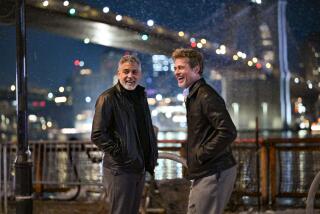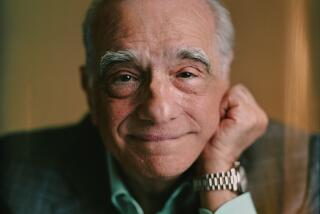HIS GLORY
Ten years ago, when Quentin Tarantino first sat down to write his own WWII extravaganza, “Inglourious Basterds,” a film he referred to as his “men on a mission” saga, he needed to come up with two story staples: a cool group of renegades and a mission. For his rough-edged warriors, he quickly settled on Jewish soldiers -- not the most obvious choice, given the legacy of Jerry Seinfeld and Woody Allen -- and for his mission, nothing less than revising history in his update of such war film staples as “The Dirty Dozen” and “The Guns of Navarone,” “Where Eagles Dare” and “The Great Escape.”
With Jews as his tough guys, there would be a certain poetic justice.
“Most of these young soldiers would have been second-generation Americans,” Tarantino says. “And they probably still had family in Poland or Czechoslovakia. It was kind of a metaphor of their European grandmothers and grandfathers and aunts and uncles being unable to fight against the Huns. But these were their American sons. Where they had to endure pain, we can inflict it.”
On a recent summer day, Tarantino delivers his patter with relish and brio. The 46-year-old director looks disarmingly chipper despite having returned only hours before from barnstorming Europe and Australia promoting the film in which his band of Nazi killers -- the “Basterds” -- mete out justice with bloody Tarantino-style poetics. Dressed in a black and white bowling shirt, he sits on an outdoor swing at his Hollywood Hills home -- a stunning view of his hometown stretched before him. Yet, all that occupies his fertile imagination at the moment are his “Basterds,” who maraud through Europe killing and scalping Nazis.
The squad is led by a dashing Southerner, Aldo Raine (Brad Pitt), who Tarantino figures cut his teeth on baiting the Klan and who takes pride in his partial Apache heritage, and also includes such idiosyncratic soldiers as Sgt. Donnie Donowitz, a.k.a. “The Bear Jew,” who bashes in Nazi heads with his baseball bat and is played by Tarantino buddy and torture-porn director Eli Roth. Ever the equal-opportunity avenger, Tarantino’s secondary story line follows Shosanna Dreyfus (Melanie Laurent), a Jewish woman who witnessed her family’s murder by the Nazis only to reemerge as a movie-theater proprietress with a plan to wreak revenge on the entire German high command.
As it happens, Tarantino isn’t Jewish. But why should that make any difference? “I don’t think there has to be a reason to have empathy or to live in somebody else’s shoes. Don’t we all wear the same shoes at one end of the spectrum or the other?”
This said, he infused the Basterds with some old-school Native American fighting tactics, pointing out he is a quarter Cherokee. “I’m actually equating the Jews in this situation, in World War II, with the Indians,” he says. “It’s not nothing that they’re doing Apache resistance. It’s not about dying. It’s about killing. They ambush their guys. They trick the enemy. It’s not a straight-up fight. And then they go and they just completely desecrate the bodies to win a psychological war.”
“Inglourious Basterds,” with its twisted spelling signaling that it is not an actual remake of director Enzo Castellari’s 1978 Italian World War II film “Inglorious Bastards” -- a Tarantino favorite -- is gory yet funny, a cathartic romp through a history significantly rewritten by one of Hollywood’s most famous autodidacts, with an almost total recall of cinematic images and story lines.
Tarantino didn’t study the actual war much. He didn’t bone up on History Channel documentaries or read up on the plight of the Jews. The only research he did was to learn a little bit about barbering because Donowitz was supposed to be a barber -- although, Roth did take it upon himself to invite Tarantino to his first Passover.
Research isn’t Tarantino’s metier. He basically picks a genre and then let’s his imagination roam. “I could have decided to do a western, but this time I decided to do a World War II movie. The sitting down -- the thing that makes me start contemplating it -- usually is that simple,” he says. “The fun part isn’t obviously to do it like the way it’s been done before. It’s to imagine what I’ll do with it.”
But sometimes he gets overwhelmed with abundance, with too many characters and plots climbing out of his head. “Inglourious Basterds” was meant to be his first original screenplay after his Oscar-winning “Pulp Fiction.” It didn’t quite work out that way. “I was understandably precious,” Tarantino explains. “It just got bigger and bigger and bigger and bigger. I had the opposite of writer’s block. I couldn’t shut my brain off.” He considered turning his growing epic into a multi-part miniseries but was talked out of that by a chance luncheon with director Luc Besson. Finally, in frustration, he just swept all the various piles of pages and notes for “Inglourious Basterds” into a box to make room for “Kill Bill,” a different sort of deadly arts epic that grew so big it was turned into two movies.
In the intervening 10 years, he’d occasionally sort the papers in the “Basterds” box, until in 2008, he hauled out the project again and wrote the current incarnation in a mere six months.
It is part of the Tarantino lore that he started his career as a maniacal video-store clerk but before that, he was an acting student who wrote scenes to provide himself with material for classes. He was in his late teens and every week he’d take a three-hour bus ride from his home in Manhattan Beach to an acting class in Toluca Lake, where he told everyone he was 21 so he could go out drinking with his classmates afterward.
“Back then, it wasn’t so easy to get scripts,” real movie scripts for class, he says. “One of the prerequisites of being a writer, or at least a good writer, is you have to have a really good memory. That’s part of your job, to remember things that people say. So, I would go see a movie and I’d just remember the scene. I’d go home right after I saw it or on the bus maybe going home and I’d write the scene down from memory and anything I didn’t remember, I filled in the blanks. Then just little by little by little, I started filling in more and more and more blanks without even realizing it. My scenes were legendary; they were literally just pieces of paper and chicken scratch and misspelled words and I’d hand it to some baffled student I’d have in my acting class.”
The jig was up, however, when one day he scribbled down scenes from the teleplay of “Marty” (later an Oscar-winning movie) by Paddy Chayefsky and handed it to a close friend who actually had the published screenplay; they compared the two to discover several added Tarantino monologues. “I go, ‘Oh, sorry’ and he goes, ‘phffff, don’t be sorry, it’s better than Paddy Chayefsky.’ Not that I’m saying that it was better than Paddy Chayefsky, but the thing is . . . that was the very first time anybody had complimented me on something I didn’t take seriously. I really thought it was worth something. From that day on, I kind of started writing a little bit more seriously.”
With “Inglourious Basterds,” Tarantino takes liberty again not with a famed writer but with actual history. As he points out, “my characters don’t know they’re part of history. There is nothing they can’t do as far as they’re concerned, right?” They just get done what they need to get done. And in so doing, the course of world events is completely changed. So what, Tarantino says with a laugh, “It only has to be plausible.”
--
More to Read
Only good movies
Get the Indie Focus newsletter, Mark Olsen's weekly guide to the world of cinema.
You may occasionally receive promotional content from the Los Angeles Times.










